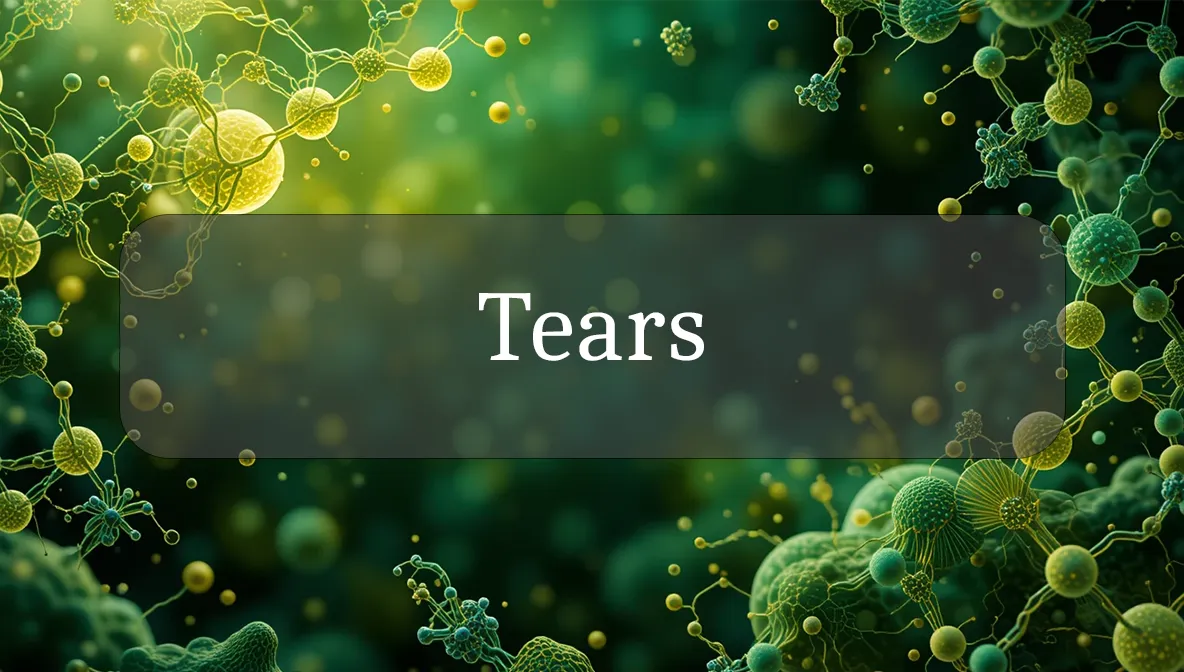Your Eyes’ Natural Protectors and Emotional Expression
Tears are more than just a response to sadness or joy—they’re a vital body fluid that keeps your eyes healthy and comfortable. Produced by the lacrimal glands, this clear, salty liquid lubricates, protects, and nourishes your eyes while also playing a role in emotional expression. Let’s explore what tears do, their benefits for daily wellness, and how to support their healthy function.
Identity and Function
Tears are a watery fluid made up of water (about 98%), salts, proteins, enzymes, and lipids (oils). They’re produced by the lacrimal glands above your eyes and spread across the eye surface with each blink. Tears come in three types:
- Basal Tears: Constantly produced to keep eyes moist and protect against debris.
- Reflex Tears: Triggered by irritants like smoke, dust, or onions to flush out foreign particles.
- Emotional Tears: Released during strong emotions (sadness, joy, or stress), containing stress hormones and natural painkillers. Their main roles include:
- Lubrication: Prevents dryness and friction on the eye surface.
- Protection: Contains antimicrobial proteins (like lysozyme) to fight germs.
- Nourishment: Supplies oxygen and nutrients to the cornea, which lacks blood vessels.
- Emotional Release: Helps regulate mood by releasing stress-related compounds.
Health Benefits and Physiological Role
Tears are your eyes’ best friends, supporting vision and overall well-being:
- Eye Health: Keep the cornea clear and moist, ensuring sharp vision and comfort.
- Infection Prevention: Antimicrobial proteins in tears reduce the risk of eye infections like conjunctivitis.
- Debris Removal: Flush out dust, allergens, or irritants, protecting delicate eye tissues.
- Emotional Wellness: Emotional tears release hormones like cortisol, helping relieve stress and promote calmness.
- Healing Support: Contain growth factors that aid in repairing minor scratches on the eye surface. By maintaining healthy eyes and supporting emotional balance, tears contribute to clear vision and a sense of well-being.
Production and Sources
Tears are produced naturally by the lacrimal glands and other eye structures:
- How They’re Made: The lacrimal glands secrete tears, while tiny glands in the eyelids (meibomian glands) add oils to prevent evaporation. Tears drain through small ducts in the inner corner of the eye into the nasal cavity (why crying makes your nose run!).
- Key Triggers: Blinking spreads basal tears, irritants prompt reflex tears, and emotions or stress trigger emotional tears via the brain’s limbic system.
- Influencing Factors: Hydration, diet, hormonal changes, and environmental factors (like dry air) affect tear production. Aging or medications can reduce output.
- Volume: Your eyes produce about 1–2 microliters of basal tears per minute, with reflex or emotional tears increasing flow significantly.
Signs of Imbalance
Tear imbalances can affect eye health and comfort:
- Dry Eyes (Insufficient Tears):
- Signs: Gritty, burning, or itchy eyes; blurred vision; or sensitivity to light.
- Causes: Dehydration, aging, autoimmune conditions (like Sjögren’s syndrome), medications (e.g., antihistamines), or screen time.
- Risks: Can lead to corneal damage or chronic discomfort.
- Excessive Tearing (Epiphora):
- Signs: Constantly watery eyes, even without emotional triggers.
- Causes: Blocked tear ducts, allergies, infections, or irritants like wind.
- Risks: May cause skin irritation around eyes or signal underlying issues.
- Abnormal Tears: Cloudy, sticky, or yellow tears may indicate infections like conjunctivitis or blepharitis. If you experience persistent dry eyes, excessive tearing, or unusual discharge, consult an eye doctor for evaluation.
Supporting Healthy Function
You can promote healthy tear production with simple habits:
- Stay Hydrated: Drink 8–10 cups of water daily to support tear fluid levels.
- Eat Eye-Healthy Foods: Include omega-3 fatty acids (fish, flaxseeds), vitamin A (carrots, spinach), and vitamin C (citrus, berries) to nourish tear glands and eye tissues.
- Blink Regularly: Take breaks from screens every 20 minutes to blink and spread tears, reducing dry eye risk.
- Use a Humidifier: Add moisture to dry indoor air (aim for 30–50% humidity) to prevent tear evaporation.
- Protect Your Eyes: Wear sunglasses to shield from wind, UV rays, or dust, and use safety goggles in risky environments.
- Manage Allergies: Use saline eye drops or consult a doctor for antihistamines to reduce irritation and excessive tearing.
Safety and Precautions
Tears are a natural fluid, but certain factors require care:
- Infections: Avoid touching eyes with dirty hands to prevent infections like pink eye, which can alter tear composition.
- Medical Conditions: Autoimmune diseases (e.g., Sjögren’s or rheumatoid arthritis) or thyroid issues can reduce tear production. Follow your doctor’s treatment plan.
- Medications: Some drugs (e.g., antidepressants, diuretics) can cause dry eyes. Discuss side effects with your healthcare provider.
- Contact Lenses: Clean lenses properly and avoid overuse to prevent irritation or reduced tear flow.
- Environmental Factors: Limit exposure to smoke, pollution, or dry climates, which can disrupt tear balance. If you have ongoing eye discomfort or vision changes, seek an eye doctor’s advice.
Fun Fact
Emotional tears are chemically different from basal or reflex tears! They contain more stress hormones and natural painkillers like enkephalins, which is why a good cry can feel so relieving.
Citations
- National Institutes of Health (NIH): National Eye Institute, Tear Film and Eye Health.
- Mayo Clinic: Dry Eyes and Excessive Tearing Overview.
- Cleveland Clinic: Tear Production and Eye Comfort.
- American Academy of Ophthalmology: Understanding Tears and Eye Health.
- World Health Organization (WHO): Vision Health Guidelines.

